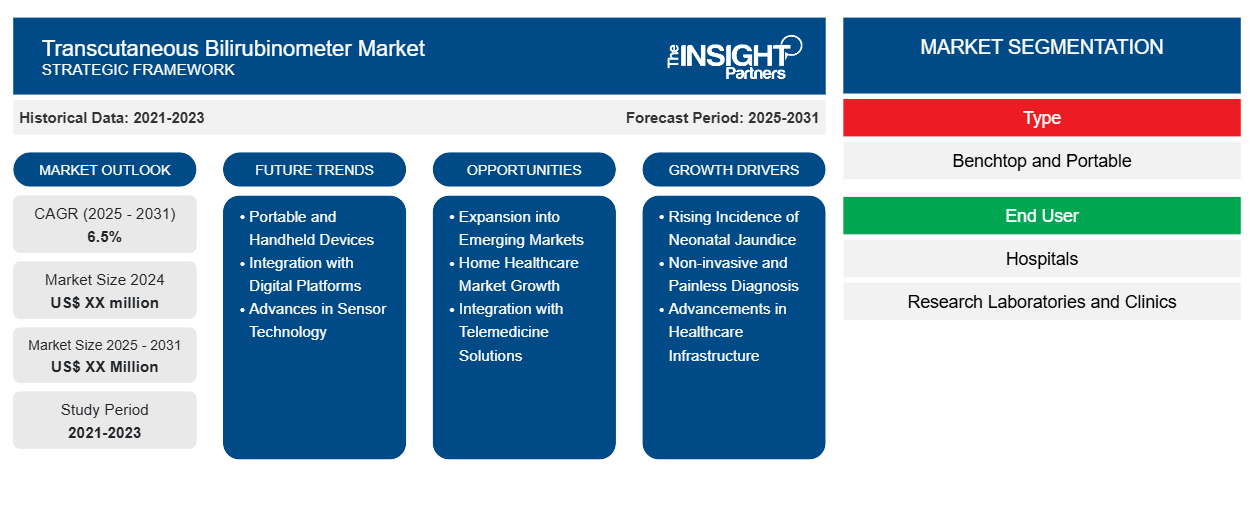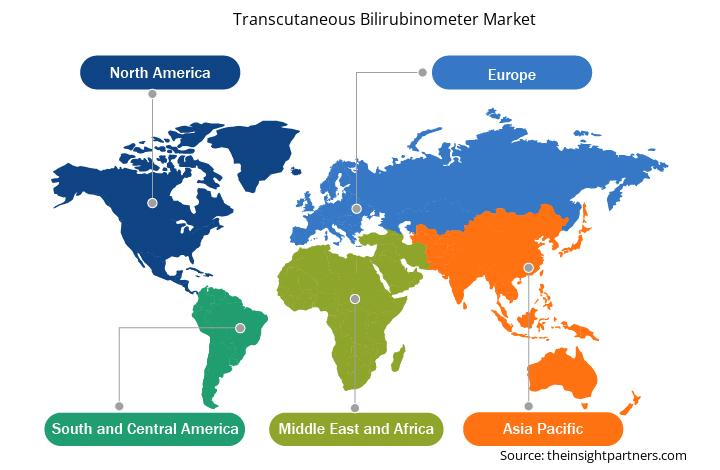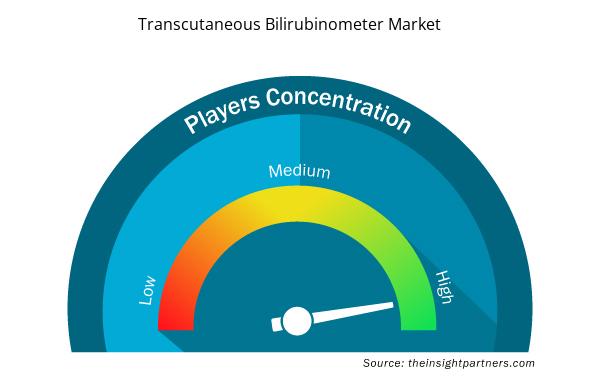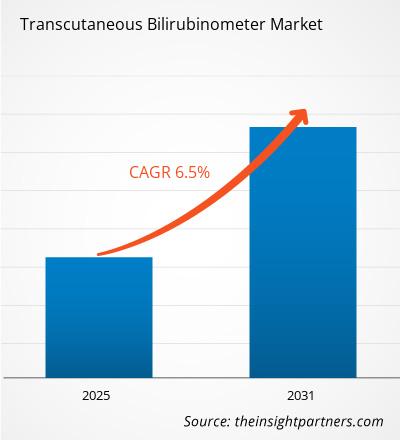The Transcutaneous Bilirubinometer Market is expected to register a CAGR of 6.5% from 2025 to 2031, with a market size expanding from US$ XX million in 2024 to US$ XX Million by 2031.
The report is segmented by Type (Benchtop and Portable), End User (Hospitals, Research Laboratories and Clinics)
Purpose of the Report
The report Transcutaneous Bilirubinometer Market by The Insight Partners aims to describe the present landscape and future growth, top driving factors, challenges, and opportunities. This will provide insights to various business stakeholders, such as:
- Technology Providers/Manufacturers: To understand the evolving market dynamics and know the potential growth opportunities, enabling them to make informed strategic decisions.
- Investors: To conduct a comprehensive trend analysis regarding the market growth rate, market financial projections, and opportunities that exist across the value chain.
- Regulatory bodies: To regulate policies and police activities in the market with the aim of minimizing abuse, preserving investor trust and confidence, and upholding the integrity and stability of the market.
Transcutaneous Bilirubinometer Market Segmentation
Type
- Benchtop and Portable
End User
- Hospitals
- Research Laboratories and Clinics
Customize This Report To Suit Your Requirement
You will get customization on any report - free of charge - including parts of this report, or country-level analysis, Excel Data pack, as well as avail great offers and discounts for start-ups & universities
Transcutaneous Bilirubinometer Market: Strategic Insights

- Get Top Key Market Trends of this report.This FREE sample will include data analysis, ranging from market trends to estimates and forecasts.
Transcutaneous Bilirubinometer Market Growth Drivers
- Rising Incidence of Neonatal Jaundice: The increasing prevalence of neonatal jaundice, a common condition in newborns, is a major driver for the transcutaneous bilirubinometer market. This condition, which causes high bilirubin levels leading to jaundice, requires monitoring for early diagnosis and treatment. Transcutaneous bilirubinometers offer a non-invasive, effective solution for monitoring bilirubin levels in newborns, fueling market growth.
- Non-invasive and Painless Diagnosis: The demand for non-invasive and painless diagnostic tools is driving the growth of the transcutaneous bilirubinometer market. Traditional methods, like blood tests, are often uncomfortable and time-consuming. In contrast, transcutaneous bilirubinometry allows for quick, pain-free measurements of bilirubin levels, making it highly preferred in pediatric care, particularly for newborns and infants.
- Advancements in Healthcare Infrastructure: Improving healthcare infrastructure, particularly in developing regions, is contributing to the market’s expansion. As hospitals and healthcare centers adopt more advanced and accurate diagnostic tools, transcutaneous bilirubinometers are being increasingly used. These devices are easier to operate and more cost-effective than traditional blood tests, making them a popular choice in both developed and emerging markets.
Transcutaneous Bilirubinometer Market Future Trends
- Portable and Handheld Devices:
There is a growing trend towards portable and handheld transcutaneous bilirubinometers. These devices are designed for convenience, enabling healthcare providers to perform quick and accurate bilirubin tests at the point of care. The portability and ease of use are particularly beneficial in neonatal units, emergency departments, and home healthcare settings, contributing to their increased adoption.
- Integration with Digital Platforms:
The integration of transcutaneous bilirubinometers with digital platforms is becoming a significant trend. These devices are now capable of storing data and connecting with electronic health records (EHRs). The data integration facilitates better tracking of bilirubin levels over time and enhances patient management, enabling healthcare professionals to make informed decisions and improve clinical outcomes.
- Advances in Sensor Technology:
Recent advancements in sensor technology have significantly enhanced the accuracy and reliability of transcutaneous bilirubinometers. Newer models use sophisticated sensors that provide more precise bilirubin measurements with minimal error. These innovations are driving the adoption of transcutaneous bilirubinometers in both clinical and homecare settings, making them a preferred choice for neonatal care.
Transcutaneous Bilirubinometer Market Opportunities
- Expansion into Emerging Markets:
There is a growing opportunity to introduce transcutaneous bilirubinometers in emerging markets where the incidence of neonatal jaundice is high, and the need for affordable diagnostic tools is critical. The rising healthcare investments and increasing awareness about neonatal care in these regions present significant growth potential for transcutaneous bilirubinometer manufacturers.
- Home Healthcare Market Growth:
The home healthcare market presents a promising opportunity for transcutaneous bilirubinometers. With an increasing number of parents seeking ways to monitor their newborns' health at home, the demand for easy-to-use, non-invasive medical devices is rising. Transcutaneous bilirubinometers could serve this need by enabling parents to track bilirubin levels conveniently, reducing the need for frequent hospital visits.
- Integration with Telemedicine Solutions:
The growing trend of telemedicine presents an opportunity for transcutaneous bilirubinometers. By integrating these devices with telemedicine platforms, healthcare providers can remotely monitor bilirubin levels in neonates. This can be particularly beneficial for rural or underserved areas, offering timely diagnosis and intervention without requiring in-person visits to healthcare facilities.
Transcutaneous Bilirubinometer Market Regional Insights
The regional trends and factors influencing the Transcutaneous Bilirubinometer Market throughout the forecast period have been thoroughly explained by the analysts at Insight Partners. This section also discusses Transcutaneous Bilirubinometer Market segments and geography across North America, Europe, Asia Pacific, Middle East and Africa, and South and Central America.

- Get the Regional Specific Data for Transcutaneous Bilirubinometer Market
Transcutaneous Bilirubinometer Market Report Scope
| Report Attribute | Details |
|---|---|
| Market size in 2024 | US$ XX million |
| Market Size by 2031 | US$ XX Million |
| Global CAGR (2025 - 2031) | 6.5% |
| Historical Data | 2021-2023 |
| Forecast period | 2025-2031 |
| Segments Covered |
By Type
|
| Regions and Countries Covered | North America
|
| Market leaders and key company profiles |
Transcutaneous Bilirubinometer Market Players Density: Understanding Its Impact on Business Dynamics
The Transcutaneous Bilirubinometer Market market is growing rapidly, driven by increasing end-user demand due to factors such as evolving consumer preferences, technological advancements, and greater awareness of the product's benefits. As demand rises, businesses are expanding their offerings, innovating to meet consumer needs, and capitalizing on emerging trends, which further fuels market growth.
Market players density refers to the distribution of firms or companies operating within a particular market or industry. It indicates how many competitors (market players) are present in a given market space relative to its size or total market value.
Major Companies operating in the Transcutaneous Bilirubinometer Market are:
- Philips Healthcare
- Natus Medical
- Radiometer Medical
- Medtronic
- Konica Minolta
- HemoCue
Disclaimer: The companies listed above are not ranked in any particular order.

- Get the Transcutaneous Bilirubinometer Market top key players overview
Key Selling Points
- Comprehensive Coverage: The report comprehensively covers the analysis of products, services, types, and end users of the Transcutaneous Bilirubinometer Market, providing a holistic landscape.
- Expert Analysis: The report is compiled based on the in-depth understanding of industry experts and analysts.
- Up-to-date Information: The report assures business relevance due to its coverage of recent information and data trends.
- Customization Options: This report can be customized to cater to specific client requirements and suit the business strategies aptly.
The research report on the Transcutaneous Bilirubinometer Market can, therefore, help spearhead the trail of decoding and understanding the industry scenario and growth prospects. Although there can be a few valid concerns, the overall benefits of this report tend to outweigh the disadvantages.
- Historical Analysis (2 Years), Base Year, Forecast (7 Years) with CAGR
- PEST and SWOT Analysis
- Market Size Value / Volume - Global, Regional, Country
- Industry and Competitive Landscape
- Excel Dataset



Report Coverage
Revenue forecast, Company Analysis, Industry landscape, Growth factors, and Trends

Segment Covered
This text is related
to segments covered.

Regional Scope
North America, Europe, Asia Pacific, Middle East & Africa, South & Central America

Country Scope
This text is related
to country scope.
Frequently Asked Questions
The main drivers include the rising incidence of neonatal jaundice, the growing demand for non-invasive and painless diagnostic methods, and advancements in healthcare infrastructure that increase the adoption of such diagnostic tools.
The trend towards portable and handheld devices enhances the accessibility and convenience of bilirubin testing, allowing healthcare providers to perform quick and accurate tests at the point of care, which is driving greater adoption in various healthcare settings.
Integration with digital platforms allows transcutaneous bilirubinometers to store and share data, enhancing patient management. This data connectivity improves clinical decision-making, making it easier to track bilirubin levels over time and improving overall patient outcomes.
Advancements in sensor technology have significantly improved the accuracy and reliability of transcutaneous bilirubinometers. More sophisticated sensors allow for more precise bilirubin measurements, which enhance the effectiveness of the devices in neonatal care.
Emerging markets present significant opportunities due to the high incidence of neonatal jaundice and the need for affordable diagnostic tools. With growing healthcare investments and improving healthcare infrastructure, there is a substantial market potential for these devices in these regions.
Integration with telemedicine platforms allows remote monitoring of bilirubin levels, providing timely care for newborns, especially in rural or underserved areas. This telehealth solution can improve diagnosis, reduce hospital visits, and enhance patient outcomes, further expanding the market for transcutaneous bilirubinometers.
Trends and growth analysis reports related to Life Sciences : READ MORE..
- Philips Healthcare
- Natus Medical
- Radiometer Medical
- Medtronic
- Konica Minolta
- HemoCue
- Dr?ger Medical
- Mennen Medical
- Bilirubin Technologies
- BiliCare

 Get Free Sample For
Get Free Sample For